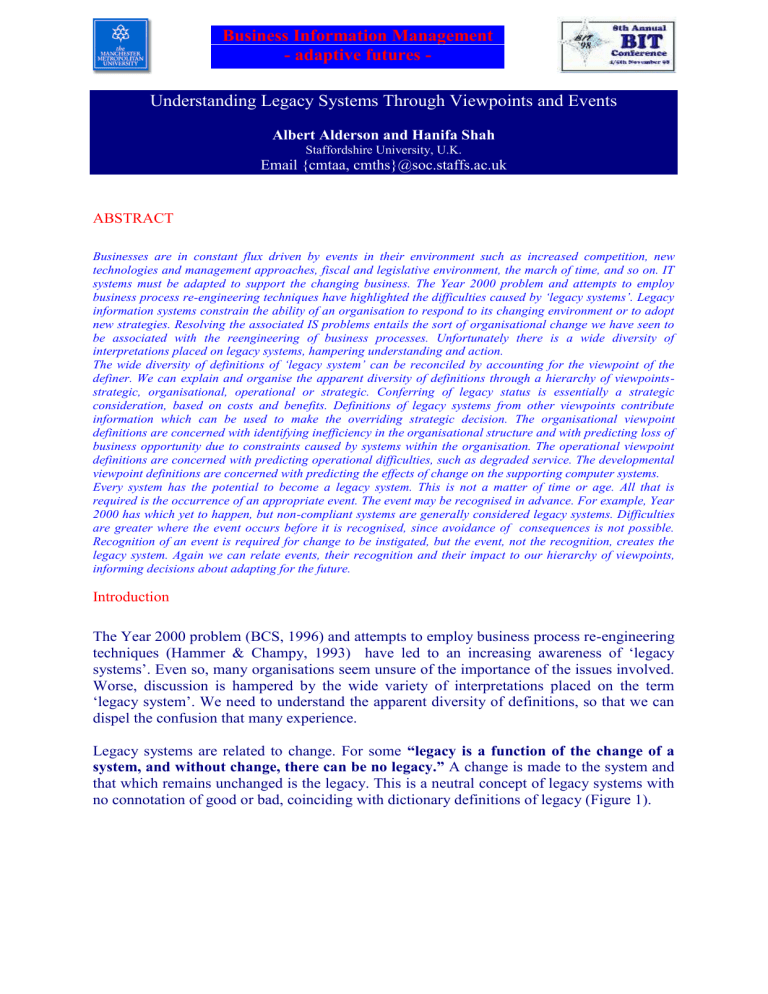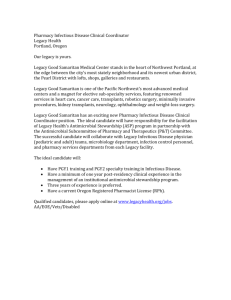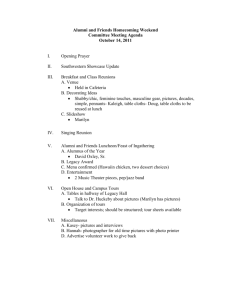Understanding Legacy Systems Through Viewpoints and Events

Business Information Management
- adaptive futures -
Understanding Legacy Systems Through Viewpoints and Events
Albert Alderson and Hanifa Shah
Staffordshire University, U.K.
Email {cmtaa, cmths}@soc.staffs.ac.uk
ABSTRACT
Businesses are in constant flux driven by events in their environment such as increased competition, new technologies and management approaches, fiscal and legislative environment, the march of time, and so on. IT systems must be adapted to support the changing business. The Year 2000 problem and attempts to employ business process re-engineering techniques have highlighted the difficulties caused by ‘legacy systems’. Legacy information systems constrain the ability of an organisation to respond to its changing environment or to adopt new strategies. Resolving the associated IS problems entails the sort of organisational change we have seen to be associated with the reengineering of business processes. Unfortunately there is a wide diversity of interpretations placed on legacy systems, hampering understanding and action.
The wide diversity of definitions of ‘legacy system’ can be reconciled by accounting for the viewpoint of the definer. We can explain and organise the apparent diversity of definitions through a hierarchy of viewpoints- strategic, organisational, operational or strategic. Conferring of legacy status is essentially a strategic consideration, based on costs and benefits. Definitions of legacy systems from other viewpoints contribute information which can be used to make the overriding strategic decision. The organisational viewpoint definitions are concerned with identifying inefficiency in the organisational structure and with predicting loss of business opportunity due to constraints caused by systems within the organisation. The operational viewpoint definitions are concerned with predicting operational difficulties, such as degraded service. The developmental viewpoint definitions are concerned with predicting the effects of change on the supporting computer systems.
Every system has the potential to become a legacy system. This is not a matter of time or age. All that is required is the occurrence of an appropriate event. The event may be recognised in advance. For example, Year
2000 has which yet to happen, but non-compliant systems are generally considered legacy systems. Difficulties are greater where the event occurs before it is recognised, since avoidance of consequences is not possible.
Recognition of an event is required for change to be instigated, but the event, not the recognition, creates the legacy system. Again we can relate events, their recognition and their impact to our hierarchy of viewpoints, informing decisions about adapting for the future.
Introduction
The Year 2000 problem (BCS, 1996) and attempts to employ business process re-engineering techniques (Hammer & Champy, 1993) have led to an increasing awareness of ‘legacy systems’. Even so, many organisations seem unsure of the importance of the issues involved.
Worse, discussion is hampered by the wide variety of interpretations placed on the term
‘legacy system’. We need to understand the apparent diversity of definitions, so that we can dispel the confusion that many experience.
Legacy systems are related to change. For some
“legacy is a function of the change of a system, and without change, there can be no legacy.” A change is made to the system and that which remains unchanged is the legacy. This is a neutral concept of legacy systems with no connotation of good or bad, coinciding with dictionary definitions of legacy (Figure 1).
Business Information Management
- adaptive futures -
“Anything handed down by an ancestor or predecessor” (OED, 1973)
“Something transmitted by or received from an ancestor or predecessor or from the past.” (WWWebster, 1997)
“A business with which one is intrusted by another.” (Webster, 1913)
Figure 1 - Definitions of Legacy
For the majority ‘legacy system’ is a pejorative term. To emphasise positive connotions there has been some use of the alternatives “heritage systems”, in the USA, and “vintage systems” in Europe. Others argue that since the legacy can be either good or bad, some other term must be found for the negative connotations. We consider that the pejorative usage is now so firmly established that any attempt to supplant it must fail, so we will use the term in that sense.
We find pejorative definitions in the literature, but in discussions and at conferences we find little evidence that those definitions are accepted by academics or industry. For example,
‘a system, originally designed to meet the historical needs of the organisation, that cannot be readily eliminated without loss of business opportunity’ (GSA, 1997).
This is objected to not least because very few systems can be eliminated without loss of business opportunity
(and that those which can are unnecessary), so we have a definition which, unhelpfully, includes all active systems.
There is no difficulty in obtaining definitions, but a great deal of difficulty in finding consensus. Indeed, we find people genuinely puzzled by the definitions that others offer. For example, business people find it difficult to understand how a product that continues to be very profitable - it earns considerably more than its associated costs - can be called a legacy system. However, it has been asserted that ‘IBM’s CICS is a legacy system because it requires legacy skills to maintain it and it is difficult to get people who have legacy skills, such as old languages and old hardware.’
There are many definitions of the term but little possibility that any one of them will be universally accepted. Without common understanding, it is difficult to have a rational debate about legacy systems, their implications, and how we might manage the problems they pose and utilise the opportunities they present.
Our view is that no single such definition is possible or even appropriate. There exist a variety of definitions all originating from different valid viewpoints or perspectives. To illustrate this the viewpoints we use are:
developmental - concerned with developing and maintaining the systems supporting the business.
operational - concerned with operating the IT systems in support of the business processes
organisational - concerned with defining and operating the business processes in support of business strategy
strategic - concerned with the strategy and finance of the organisation.
Clearly, other viewpoints could be identified but we find this a useful set.
Gold (1998) also considers a similar, but less detailed, viewpoint approach to considering legacy systems.
Business Information Management
- adaptive futures -
We suggest that we can progress with a variety of definitions provided we understand the viewpoint. In the following sections, we consider the concept of events causing legacy system status, and consider a variety of definitions of “legacy system”. We identify the viewpoints associated with these. Having understood the viewpoints, we consider the options for addressing legacy system situations.
Events
Every system has the potential to become a legacy system. This is not a matter of time or age.
All that is required is the occurrence of an appropriate event. An event does not change the system. It may change some aspect of the system environment in such a way that change to the system is considered necessary. It may indicate problems with the system itself. The need for change created by an event, not the event itself, is indicative.
Fitzgerald (1998) identifies the prime causes of changes to systems as improper specification implementation, inadequate original specification, organisational change, personnel change, changes in the law, external changes (such as by banks, Inland Revenue, suppliers), technology (old, no longer maintained), strategic development, and new policies. Considering these, we see that each is the consequence of some event - some decision or occurrence which is pertinent to the system. Events need not be point events, for example the challenge of globalisation can be viewed as stretched out over time.
Events may occur long before they are recognised. An accumulation of unrecognised events could lead to a growing sense of dissatisfaction over time, for example, with performance as volumes slowly increase. A breach of security is recognised after the event. (If we recognise it before it occasions damage we call it an attempted security breach.) A complaint from developers that “users are not using the system properly” may be an indication that events are forcing users to behave differently because the system has not dealt with those events.
Equally, events may be anticipated as with the Year 2000 problem.
Recognition of the event is key. Recognition is required for change to be instigated, although it is the event, not the recognition, that creates the legacy system. As the system does not become a legacy system before the event occurs, then legacy status can be avoided by making anticipatory changes. However, when an event occurs before it is recognised, avoidance of consequences is not possible.
Events may occur externally, in the environment of the organisation, or internally, within the organisation. External events might be change in fiscal regime, competition, etc. Internal events might be due to new business direction, technical innovation, etc. The organisation will usually have no control over external events (although very large corporations may have some influence). The organisation may often have control over internal events. In particular, there may be control of events caused by decisions.
Many events are the outcome of decisions made internally and externally, as we can recognise from Fitzgerald’s list above, and announced in advance of the required implementation date. Taxation changes, European Monetary Union and the introduction of the European common currency are current examples of such external events. Year 2000 is a consequence of a decision made and announced by Pope Gregory, although the consequences have been discovered rather late by many who are affected. This particular
Business Information Management
- adaptive futures event emphasises that recognition may not be followed by remedial action if the consequences are not recognised.
It is useful for organisations to understand their degree of choice to address the consequences of an event or not. For any organisation to ignore Year 2000 would seem foolhardy, probably presaging that organisation’s demise. Year 2000 is probably unique in this respect. For all decision events someone (external or internal) has a choice whether to cause them or not (as with the decision to proceed with EMU). For internal decision events the organisation has the ability to cause the event to happen or not - as in strategic and policy changes. However, deciding to maintain the status quo is still an event and may also have consequences.
The rate of occurrence of events is significant. Systems which are changed frequently are often less difficult to amend than those that are changed rarely, since the maintenance skills are well practiced. Regular events, such as taxation changes, can be anticipated to the extent that system developers, usually, have made it easy to apply the necessary changes.
Figure 2 summarises this discussion as a classification of events.
EVENT
Classification
External
Internal
Imposed
Avoidable
Rate
Recognition
Anticipated
Not anticipated
Figure 2 - Classification of Events
It may also be of value to discuss the level at which the organisation is affected by or may recognise the event. We will defer this discussion until we have considered our viewpoints.
Viewpoints
The Developmental Viewpoint
Those responsible for the development of new systems and the maintenance of existing systems have a very straightforward view of legacy systems. This stems from their awareness of the affects of change upon the products of the development process. Therefore, we have a software orientated definition of a legacy system as ‘any code that has left development.’
Many readers will find this definition extreme, because it includes every (potentially live) system. Another software orientated definition is
‘a system becomes a legacy system when you write the second line of code.’ One could go further and say - ‘as soon as the first
Business Information Management
- adaptive futures piece of design has been done’
or
‘as soon as the first requirement has been captured’
.
These subsequent definitions seem even more extreme. However, taking a developer’s viewpoint, we see that these definitions are concerned with the difficulties caused by changes in requirements. All of these definitions clearly have a maintenance viewpoint. They are all focused on change in the various representations of the system itself.
The definitions are predictive. They tell us when a system becomes a legacy system.
However, we may justifiably point out their low utility since they all encompass every system as soon as it reaches some defined point in the development process. They do no more than indicate the need to understand that maintenance issues should be considered for all systems, at all stages of development, since change is inevitable.
Another aspect of the developmental viewpoint was indicated in the case of CICS. Here a legacy system is one
‘handed on by those who were expert, but who are no longer involved, to those who are not expert.’
This expresses the need for information and skills to maintain the system, and corresponds to personnel change in Fitzgerald’s list above..
Operational Viewpoint
The operational viewpoint is concerned with supporting the business by operating its systems. There is a continuing need to provide an efficient service for the necessary volume of information gathering and query, within appropriate response times. Systems which can no longer be operated to meet any of these requirements may be labelled legacy systems.
Legacy system definitions from the operational viewpoint concern these issues. For example
“an operational system that was written using hardware and/or software which is no longer seen as part of the organisation’s current strategy” . This could be construed as measuring systems by business fashion not by business need, especially by an executive wanting to keep the lid on the IT budget. However, poor interoperability of systems can hamper effective service.
That a legacy system is
“one that is old”
could be considered ageism, but it is indicative of the difficulty in keeping old hardware operative or of systems that provide less effective user interfaces than modern ones.
One interesting definition reflecting changing systems architectures is that
“a system whose security has been compromised”
is a legacy system.
Organisational Viewpoint
The organisational viewpoint is concerned with defining and operating the business processes in support of business strategy. Legacy systems are particularly important since they
“ constrain rather than support the ability of the organisation to respond to changing environment conditions or to adopt new strategies.
” Moreover, resolving the associated IS problems entails the sort of organisational change we have seen to be associated with the reengineering of business processes. “
If a re-engineering of business processes proposed to enhance efficiency (or any other high-level organisational goal) is frustrated by inflexibility of existing information systems”
, then these become legacy systems. This may be restated as “ systems that do not support changed business needs.
”
Business Information Management
- adaptive futures -
However, it is at the operational level that we encounter a positive and important aspect of legacy systems - they are “ old, inflexible, expensive, non-portable and undocumented but indispensable because they support core business functions.”
Strategic Viewpoint
From the strategic viewpoint we consider the financial costs and benefits of running the organisation. The financial community have long understood that an organisation that is not
‘able to meet its debts as they fall due’
is a candidate for major reengineering (as in the UK concept of ‘administration’ and the US concept evoked by ‘Chapter 11 operation’) or must cease to operate. Perhaps we can say that this defines a ‘legacy organisation’.
The strategic level is concerned with changing the company in response to events in its environment which provide threats or opportunities. The events may be political (trading or not with certain countries, regulation, deregulation), economic (monetary union, currency fluctuations, interest rate changes, taxation such as windfall tax), competitive or new technical innovation.
The functions of the organisations are supported by work processes which in their turn are supported by computer systems. From a strategic viewpoint, these supporting computer systems become legacy systems, when ‘ the financial benefit they contribute to the organisation is less than the cost of operating and maintaining them’
.
From this viewpoint we must consider the cost of lost opportunity where a legacy system
“ cannot support a desired business opportunity, so preventing an organisation earning from that business opportunity”.
We can then make financial decisions about whether it is appropriate to develop the legacy system further, replace it by a new system, run in parallel with a new system, or do nothing. Note that we must use the lifetime cost of ownership - purchase, maintenance, operation and replacement (including cut-over) cost, when costing new systems.
Events and the Viewpoint Framework
Generally we would expect each viewpoint to respond to events from the environment or generated by viewpoints higher in the hierarchy, and indeed we find echoes of this in the definitions of legacy systems that are used at each level.
The strategic viewpoint deals with all external events, unless they have been previously anticipated and the means of change to cope with them has already been defined with responsibility assigned to some other level of the organisation. The strategic viewpoint also generates strategic and policy change events, perhaps in response to external events, but also to internal events. The organisational viewpoint responds to such events, generating further events, and so on through the hierarchy.
It is interesting that the only events connected with the view that a legacy system is “one that is old”
are the ticks of the clock. Perhaps this indicates that definitions of legacy systems are likely to be weak when based on such non-specific events.
What to do about Legacy Systems
Gold (1998) discusses the importance of predicting the legacy event stating that predicting future occurrences (or even identifying the event having occurred) would enable ‘future
Business Information Management
- adaptive futures proofing’ of the system and prevent serious degradation. Our research recognises that there are a wide variety of available approaches to resolving legacy problems, which we categorised in Figure 3. It must be recognised that to do nothing may be a perfectly valid business option. The cost of acting may not be cost justifiable in the context of the potential business opportunity. Indeed acting may be beyond the financial resources of the organisation. The strategic level must decide whether acting or not would be in the interests of the organisation. For example, a business view has been expressed that it may be in the shareholders best interests to wind-up a company before Year 2000, avoiding the associated costs and risks. The other strategic choices are to address a problem in-house or use facilities management.
Figure 3 - Options for Addressing Legacy Systems
If the strategic level decides that in-house change is required, the organisational level must determine how to achieve the necessary change. Business process reengineering may be required. Options are to reuse or replace the legacy system. Expertise may be required from the operational and developmental levels to inform the decision at the organisational level.
Changes required as a result of opting for the reuse option will be carried out by the developmental level.
Replacement may be achieved by redevelopment according to the updated requirements or by using a commercial off-the-shelf system (COTS) or package. Reuse may could take the form of refurbishment, conversion or reengineering. Refurbishment involves improving the application code by restructuring and improving aspects like data accesses It is applicable when there has been structural decay due to repeated modification. Conversion is involves transfer of the application software to a new environment, say from a mainframe to a workstation, and can be highly automated. While refurbishment and conversion can overcome operational difficulties, they do not address other concerns. The range of technical approaches available to reengineer legacy systems has been set out by Chikovsky and Cross
(1990) who define reverse engineering as the process of analysing a subject system in order to identify its components and how they are inter-related and to create higher level abstractions or alternative forms of representation of the system. They relate important terms in the area of reverse engineering and show how these map to a three stage life cycle model based on different abstraction levels: requirements (constraints, objectives, business rules), design (solution specification) and implementation (coding, testing and operational system delivery).
The operational level has responsibility for ensuring that the requirements for replaced or reused systems are understood. It is also responsible for accepting the replacement or reused
Business Information Management
- adaptive futures system into service. The developmental level is responsible for creating or obtaining the required system.
Summary
The viewpoints on legacy systems that we identify form a hierarchy of priority. Overriding all is the strategic viewpoint protecting the shareholders interests. This viewpoint decides whether or not to act to address a legacy system issue. Next in importance is the organisational view adapting and amending the organisational structure and its business processes. This view decides on the approach to resolving a legacy system issue. Subordinate to this is the operational viewpoint, ensuring that the systems in place deliver their intended services. Subordinate to all is the developmental viewpoint, ensuring that the required systems are in place and are maintained in response to the needs of the other viewpoints.
Events, their recognition and assessment of their consequences, are key to the legacy status of systems. Conferring of legacy status is essentially a strategic consideration, based on costs and benefits. Definitions of legacy systems at other levels contribute information which can be used to make the overriding strategic decision. The organisational viewpoint definitions are concerned with identifying inefficiency in the organisational structure and with predicting loss of business opportunity due to constraints caused by systems within the organisation.
The operational viewpoint definitions are concerned with predicting operational difficulties, such as degraded service. The developmental viewpoint definitions are concerned with predicting the effects and costs of change on the supporting systems.
Through a viewpoint approach we can reconcile apparently conflicting, or even apparently valueless, definitions of legacy systems, creating a flow of predictions about the status of systems enabling determination of legacy status and facilitating appropriate response in the context of the business.
Acknowledgment
The definitions of legacy systems in this paper are anecdotal. They have been gathered from discussions with senior business people, from opinions expressed at conferences and seminars, and developed with colleagues. We thank them all for the inspiration their thoughts have given us. However, we feel it would be unfair to name individuals in the context of this paper.
We acknowledge the support of EPSRC through SEBPC Grant No. GL/L43473.
Business Information Management
- adaptive futures -
References
BCS (1996) The Year 2000: A Practical Guide for Professionals and Business Managers . British Computer
Society.
Chikovsky, E.J. and Cross II, J.H. (1990) Reverse Engineering and Design Recovery: A Taxonomy. IEEE
Software 7(7), 13-17.
Fitzgerald, G. (1998) Plenary Address to BCS 6th International Conference on Information Systems
Methodology, 3-4 Sept 1998, Salford, UK.
Gold N.E. (1998) The Meaning of the Term “Legacy System”.
Computer Science Department Technical
Report Series No. 7/98, University of Durham, UK.
GSA, (1997), http://www.itpolicy.gsa.gov/modelirm/appena.htm, US General Services Administration. [No longer extant]
Hammer M. & Champy J. (1993) Re-engineering the Corporation: A Manifesto for Business Revolution ,
Nicholas Brealey Publishing Ltd.
OED, (1973), The Concise Oxford Dictionary, Oxford University Press.
Webster, (1913), Webster’s Revised Unabridged Dictionary.
WWWebster, (1997), WWWebster Dictionary.







